Menus
- 2-stroke versus 4-stroke
- Smooth stones, loose chunks, greasy driveways
- The only way to success is through self-restraint
- MOTORCYCLE conclusion
- Interview with Joachim Sauer
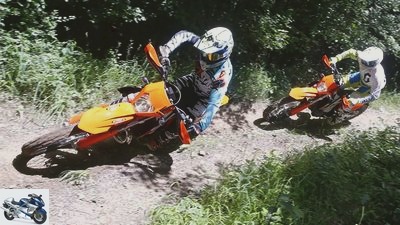


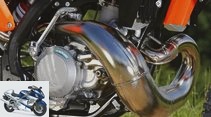
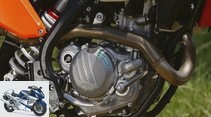
11 photos
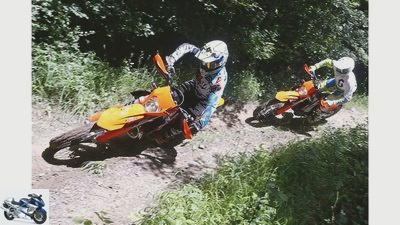
1/11
The two-stroke engines are celebrating their comeback in off-road racing. MOTORRAD has tested the KTM 300 EXC and the 500 EXC-F.

2/11
The high-flyers: Whether two or four-stroke – KTM is the power in enduro sport.
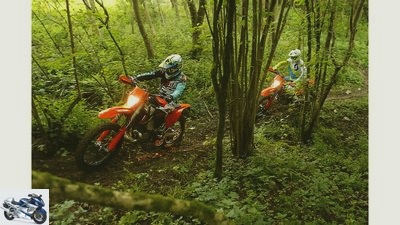
3/11
While the heavier and more expensive four-stroke engine shines with its easily controllable performance characteristics, the lighter and velvety running two-stroke model impresses in the undergrowth. On the cross test, however, the bite of the 300 challenged the pilot.
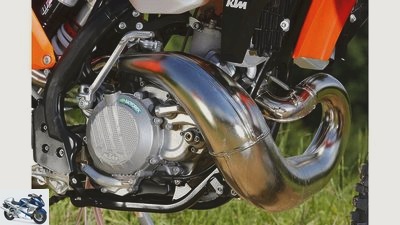
4/11
In the 2017 sports enduro bikes, the KTM technicians hardly left a screw untouched. The two-stroke engines received integrated electric starters and a balance shaft,…
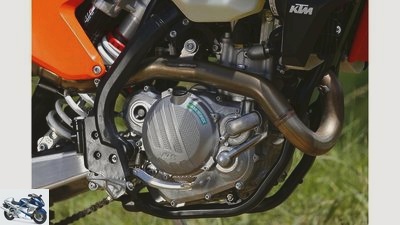
5/11
…the four-stroke engines have a more compact engine case.
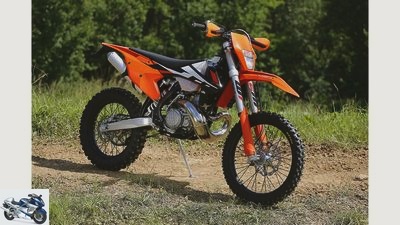
6/11
KTM 300 EXC.
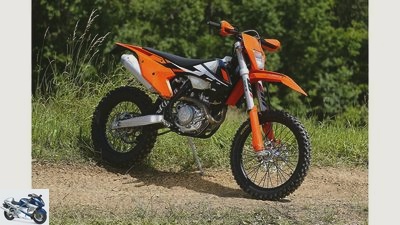
7/11
KTM 500 EXC-F.
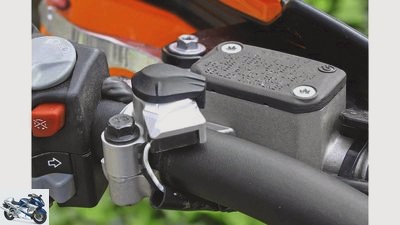
8/11
The effect of the setting options for the ignition curve on the 300…
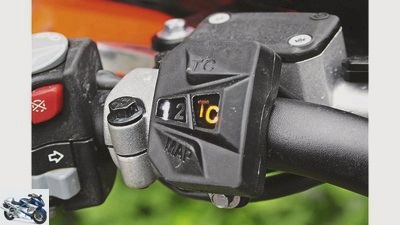
9/11
…and that of the mappings including new traction control on the 500 remains marginal.

10/11
Concept comparison of sports enduro bikes KTM 300 EXC and KTM 500 EXC-F.
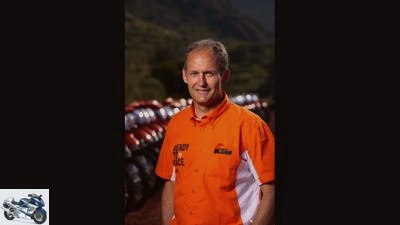
Campelli
11/11
Joachim Sauer: “We can’t avoid an injection”.
KTM 300 EXC and KTM 500 EXC-F in the test
2-stroke versus 4-stroke
For a long time, the two-stroke engines seemed doomed to become extinct in off-road sports. But the simple technology has long been celebrating a comeback. Does it dig its way over stick and stone just as well with the circular saws as with the established four-stroke machines? MOTORRAD tried it with the KTM 300 EXC and KTM 500 EXC-F.
S.or more than a decade, MOTORRAD has not tested any two-stroke sport enduro bikes. The reason: Because of the aggressive power development of the two-stroke engines, essentially only competitive pilots were enthusiastic about the simple technology. Hobby and leisure off-roaders are relying more and more on the more easily manageable four-stroke models – especially after the 350 cm³ engines were launched in 2012.
Buy complete article

KTM 300 EXC and KTM 500 EXC-F in the test
2-stroke versus 4-stroke
KTM meanwhile produced every second sport enduro with a two-stroke engine (see interview). And both marketing strategists and the winners of popular extreme enduro bikes like the Erzberg Rodeo declare in unison: two-stroke engines have become more sociable.
Smooth stones, loose chunks, greasy driveways
Well, the Schnurle reverse flush is also given a second chance at MOTORRAD. It is the two biggest who represent their guild: the KTM 300 EXC as the best-selling two-stroke enduro and its counterpart with the largest displacement in the four-stroke segment, the KTM 500 EXC-F. Both are already completely revised 2017 models with a new frame and new engines (see MOTORRAD 14/2016). But it is about fundamentals. The price, for example: 1200 euros less than for the 9995 euros expensive 500cc hike for the two-stroke KTM (8795 euros) over the counter. Or the weight: five kilograms is the difference between the 102-pound 300 and the 107-pound 500 (weight with empty tank). For orientation: This means that the two enduros are only two to three kilograms more than their comparable motocross sister models, despite the lamp mask and more voluminous silencer. Impressive.
Start: No issue. E-starters are good form in enduro sports, even with two-stroke vehicles. Anyone who has ever practiced the involuntary balancing act with a stalled engine on an incline will think the button is a good idea. Warm-up? A few meters should be enough. The two-stroke flatters itself. The lower moving masses generally ensure a well-groomed appearance. But with the balancer shaft used for the first time in the 2017 variant, the KTM 300 EXC demonstrates how important smooth running can be off-road. In direct comparison, it is almost ashamed of the four-stroke single. However: without the model student, the four-stroke driver hardly notices the fine tingling sensation in footrests and handlebar ends.
Instead, he looks forward to the first counterattack. Smooth stones, loose chunks, greasy driveways – this is where enduro core competencies are demonstrated. Long the domain of the four-stroke engine. Plenty of traction, no sudden breakouts. The modern shooters have established their good reputation with their easily calculable commitment. And indeed thunders
The KTM 500 EXC-F is also finely controllable through the rough and runs cleanly on track. Little gas, a lot of gas – it always works. Keeping the two-stroke in check here shouldn’t be a problem.
The only way to success is through self-restraint
Think. Because something has happened over the years. The EXC babbles very smoothly, pushing horse and rider through the uncomfortable as smooth as butter. On the KTM 300 EXC, the exhaust control slides remain closed up to 5400 rpm – i.e. up to two thirds of the nominal speed of 8200 rpm. In this area, the two-stroke engine behaves as piously and first-classly as a trial engine and is clearly superior to the four-stroke engine. But only there. Anyone who turns the gas too enthusiastically will – when the exhaust control opens – be wagged as ever by the biting start through the botany. The only way to success is through self-restraint. Or more specifically: If in doubt, simply shift up, let the engine pull at low speed, and then it fits.
Change of location. Tight hairpin bends, hard ground, long jumps – the terrain for special stages, club cross races or popular cross country events. In terms of driving, it’s the opposite of the traditional Enduro on the slippery slopes. Technically too. Brake harder, accelerate more vehemently, turn higher and shift more. Advantage two-stroke? At first yes. Without any significant engine brake, the KTM 300 EXC rolls like a moped into the neighboring areas and feels considerably lighter than the four-stroke just because of this easy running. In addition, the low drag torque when braking or rolling puts much less strain on the fork, making the front of the brake shafts sniff more sensitively. Even when jumping, the 300 throws itself in the chest. The slightest throttle is enough to catapult the flyweight on the table top a few meters further. However: on hard or even damp terrain – that is, in the vast majority of cases – this liveliness takes its toll. After the bends, the two-stroke engine snaps up the speed ladder in a flash, demanding maximum commitment from the pilot. The search for traction becomes an overriding task. If you don’t master the harmonious game of gas and clutch, the KTM 300 EXC will suck your stamina and concentration out of your body like a leech. The second ignition curve, which can be selected via the handlebar switch, hardly changes that. The differences in the power output are marginal.
Just as little as the effect of the four-stroke engines, which were equipped with two mappings and for the 2017 season for the first time with traction control. Which hardly concerns the 500 pilots. The 57 HP are worlds easier to control than the 47 horses of the two-stroke sister. And just as the KTM 300 EXC torpedoed its many advantages with its agitated engine characteristics, the KTM 500 EXC-F with its sovereign drive overcomes its weaknesses. And the front, which is more wobbly due to the drag torque, or the more sluggish handling is often exchanged for the uncomplicated and energy-saving character that the four-stroke engine offers even in its largest version.
In this respect: With first-class smoothness, low weight and very good controllability in extreme terrain, the KTM 300 EXC provides good arguments for modern two-stroke technology. On the usual slopes and with a normal endurance driver in the saddle, the user-friendly characteristics of a four-stroke engine are still the decisive criterion.
MOTORCYCLE conclusion
The example of the KTM 300 EXC shows: The new generation of two-stroke engines with balancer shafts and electric starters offer more smooth running and playful handling than ever before. But if you are looking for the efficient all-rounder, you will still be happier with a four-stroke. The revolution did not materialize.
Interview with Joachim Sauer
Joachim Sauer (54), Offroad Product Manager at KTM, on the future of two-stroke technology in sport enduros.
Campelli
Joachim Sauer: “We can’t avoid an injection”.
How big is the share of two-stroke bikes in sport enduros?
KTM produces around 35,000 sport enduros every year. In Europe around half of them are ordered as two-stroke engines. The tendency is slightly increasing. Two-stroke engines are cheaper to buy and cheaper to maintain. Four-stroke engines are technically much more complex and therefore more expensive to repair.
The Euro 4 standard will come into force on January 1, 2017. However, the 2017 KTM two-stroke engines are only homologated to Euro 3. Does that mean that all 2017 models have to be registered this year?
Basically, all two-stroke engines have to be registered in 2016. However, it is possible to register a certain number of vehicles after the deadline. However, this measure only affects vehicles specifically specified by the manufacturer with chassis and engine numbers. The customer must therefore have the dealer clarify the eligibility for approval in each individual case.
This means that fundamental technical changes are required for the 2018 models in order to be able to homologate the two-stroke engines.
Yes, we will not get around an injection. However, it is not enough to replace the carburettor with an intake manifold injection. Injection technology is required that is relatively complex.
However, this makes two-stroke technology more complicated. Doesn’t this concept lose its advantages?
Only in part. The weight advantage remains, there is no need to jetting around the carburetor and fuel consumption is drastically reduced. This is a new world.
Related articles
-
Beta RR 350, Beta RR 390, Beta RR 430 and Beta RR 480 in the test
beta 10 photos beta 1/10 In the off-road sector, KTM and Husqvarna are almost overwhelming – but with beta … beta 2/10 The best compromise between the…
-
Beta sports enduro in the test compact
Manufacturer 23 photos Manufacturer 1/23 Beta sports enduro bikes, 2014 models, in the test compact. Manufacturer 2/23 Beta sports enduro bikes, 2014…
-
fact comparison test Crosser in suspension It seems clear that the four-stroke crossers in the small class will soon take over the helm. But now?…
-
2017 KTM sport enduros in an individual test
StudioMAC 8 pictures StudioMAC 1/8 KTM 250 EXC-F. StudioMAC 2/8 The central on-board electrical system under the bench, the Li-ion battery weighs only half a …
-
Marco Zamponi 14th photos Marco Zamponi 1/14 Picture gallery, sport: The Suter MMX 500 is to show on the Isle of Man that the two-stroke engines still…
-
Husqvarna FE 350 and Husqvarna TE 300i in a comparison test
Husqvarna FE 350 and Husqvarna TE 300i in a comparison test Cloudy to clear The days of blue two-stroke clouds are (almost) over. Because…
-
2017 travel enduros from BMW, Ducati, Honda, KTM and Triumph in a comparison test
Rivas 50 photos Rivas 1/50 2017 travel enduro in comparison test. Rivas 2/50 BMW, Ducati, Honda, KTM and Triumph in the battle for control of the travel…
-
Beta sports enduro bikes (model year 2018) in an individual test
beta 9 photos beta 1/9 The new Beta RR 125 2T in the driving report. beta 2/9 Flat piece: The narrower coupling enables a flatter housing cover. An…
-
Aprilia RSV4 RF and Yamaha YZF-R1M in comparison test
40 photos markus-jahn.com 1/40 Aprilia RSV4 RF and Yamaha YZF-R1M in comparison test. markus-jahn.com 2/40 You sit quite high on both bikes, but with the…
-
Husqvarna Crosser 2015 in the test
Campelli 34 photos Campelli 1/34 Campelli 2/34 The first contact with the new huskies took place in Luleå, Sweden, and MOTORRAD tester Didi Lacher,…